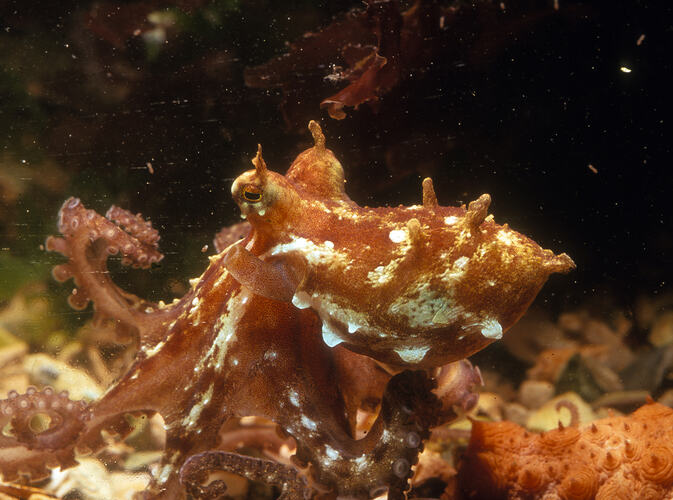General Description
Small, pygmy octopus. Body oval-shaped with pointed rear tip. Colour red-brown with white markings. Sides of body with two rows of regular, white, elongated papillae (flaps of skin), from which species gets its common name. Unbranched fingers of skin may be raised all over the body. A single finger of skin above each eye. Mantle length to 3 cm, total length to 9 cm.
Biology
There is very little known about this pygmy octopus as most specimens have been collected from shallow water trawls. As with other pygmy species, their small size allows them to live in habitats out of sight of humans, such as deep amongst the leaves and roots of seagrasses or seaweeds. The only record of a wild observation was a single animal camouflaged as a piece of red seaweed, hitching a ride on the back of a large shellfish, a Wavy Volute snail. It is assumed that they eat crustaceans like most other octopus species. Pygmy octopuses have probably evolved from the pressures to remain hidden. Octopuses make an excellent meal; they lack spines or armour and most lack poisons. Being small helps them to remain hidden from larger fish predators. Some pygmy octopuses spend most of their lives hidden in the roots of kelps or small coral heads, feeding on the many small crustaceans and fish that also seek shelter in these refuges. Natural selection would favour octopuses that mature at smaller sizes so that they can reproduce without being forced out of their safe havens. Some pygmy species are adult at the size of a fingernail, weighing less than a gram. Little is known of reproduction in this species. Females produce large eggs that would hatch into bottom-living young.
Distribution
South-eastern Australia.
Habitat
Sand or mud substrates, often in seagrass beds or sponge gardens, to a depth of at least 69 m.
More Information
-
Animal Type
-
Animal SubType
-
Brief Id
8 arms, single raised papilla of skin above eye, skin may have raised unbranched papillae, red-brown with white markings on side of body.
-
Colours
Red, Brown, White
-
Maximum Size
10 cm
-
Habitats
-
Diet
Carnivore
-
Hazards
Potential to bite, especially if handled. Venom status unknown.
-
Endemicity
-
Commercial
No
-
Conservation Statuses
CITES: Not listed, FFG Threatened List: Not listed, DSE Advisory List: Not listed, IUCN Red List: Data Deficient
-
Depths
Shallow (1-30 m), Deep ( > 30 m)
-
Water Column Locations
On or near seafloor
-
Taxon Name
-
Scientific Author
Quoy & Gaimard, 1832
-
Common Name
Frilled Pygmy Octopus
-
Phylum
-
Class
-
Subclass
-
Order
-
Suborder
-
Family
-
Genus
-
Species Name
superciliosus

